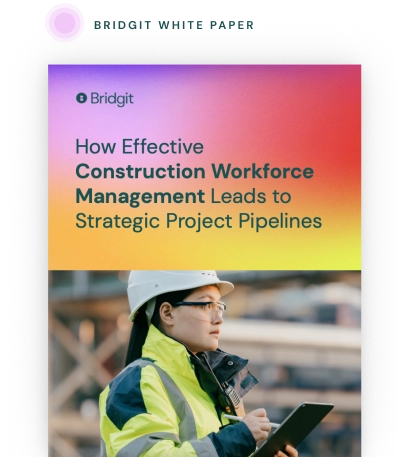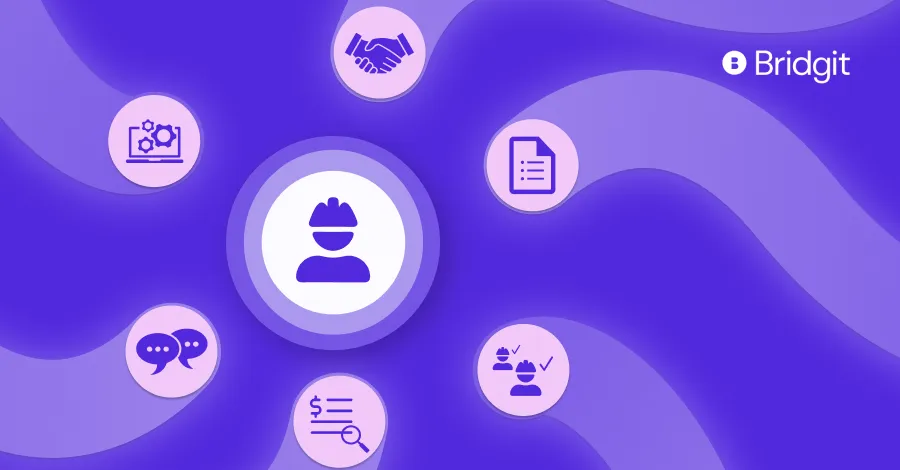Subcontractor management is among the most important aspects of any general contractor’s work. Keep reading as we share a few tips for managing subcontractor performance and scheduling efficiently.
Table of Contents
What is subcontractor management?
Subcontractor management is the process of procuring subcontractors and overseeing their work on behalf of a client. In construction, general contractors are responsible for this.
The subcontractor management process takes place in four phases:
- Pre-award
- Award
- Post-award
- Close-out
Let’s take a closer look at what happens in each one.
Pre-award
During this stage, general contractors assess the project’s needs. They subsequently send out requests for quotations (RFQs) and requests for proposals (RFPs) to subcontractors.
Award
In this stage, general contractors review bids and proposals from subcontractors in search of the best candidates. Once suitable subcontractors have been selected, general contractors will work with them to hammer out specific contract details.
Post-award
At this point, the project is in full swing. General contractors monitor subcontractors to ensure they’re operating on schedule and in accordance with quality and safety standards.
Subcontractor management in this phase may also involve addressing requests for information (RFIs) and keeping subcontractors informed of client requests.
Close-out
During this final phase, general contractors thoroughly inspect each subcontractor’s work. They may request – and follow up on – change orders if the work isn’t sufficient.
Subcontractor management best practices and tips
Now that you know what subcontractor management entails, let’s discuss a few tips and best practices.
1. Pre-qualify subcontractors carefully
Good subcontractor management starts in the pre-award phase. In other words, before you think about coordinating subcontractors on your job site, make sure you’re working with the right subcontractors, to begin with!
Best practices when selecting subcontractors include:
- following up with their prior clients and references to ensure they have a track record of delivering solid work
- comparing several subcontractors before making a decision
- looking beyond price to ensure the subcontractor is available, qualified, and insured
- being compared to make a competitive offer for the ideal candidates
With the right subcontractors in place, your job will become much easier. Don’t bulldoze through this part of the process!
Note that it’s important to pre-qualify subcontractors even if you’ve worked with them before. Things change. Their certifications may have lapsed or they may have lost key team members, resulting in poorer quality work. You won’t know until you check.
It’s in everyone’s best interest that you as a general contractor be as clear as possible in your instructions. This should start in the pre-award phase, which is when subcontractors start planning their resource allocation strategy.
Of course, there will often be situations in which the scope of work changes unexpectedly. Communicating these alterations as quickly as possible can mean the difference between meeting your client’s expectations and falling short.
3. Use purpose-build resource management software
The era of tracking subcontractors and other resources in spreadsheets is behind us. Today, savvy general contractors use dedicated programs like Bridgit Bench to manage subcontractor schedules, assignments, labor requests, and data.
With Bridgit Bench, you can very clearly visualize allocations in an industry-standard Gantt chart format and properly plan your labor strategy. As your project progresses, effortlessly see how changes are affecting existing allocations and create forecasts that keep everything on track.
Read this article for some more tips on assembling a solid general contractor software suite.

Use your workforce data to create a competitive advantage
Download our white paper to see how effective workforce planning can help stay ahead of labor demands and create a strategic project pipeline.
4. Set up reliable communication channels
No construction project can succeed without proper communication between general contractors and subcontractors. Communication keeps everyone informed and working together to achieve success.
Subcontractor management programs like Bridgit Bench can facilitate communication by making it easier to generate reports and keep data in a centralized location. Check out this article for a list of other tools general contractors use to ensure effective communication among laborers.
Subcontractors should know their point of contact for various types of requests, whether they relate to safety, quality, the project’s schedule, or anything else.
5. Put contract details in writing
Professionals who know how to manage subcontractors effectively recognize the importance of getting important commitments in writing. Verbal agreements can be easily forgotten and may not hold up in court quite like commitments made in your subcontractor agreement would.
Consequently, if a particular deliverable is important to you or the client, get it in writing to avoid potential conflicts.
6. Pay special attention to payment terms
The subcontractor payment terms you agree to will have a massive impact on project financials. There are a few common options, including:
- pay-when-paid, which stipulates subcontractors won’t be paid until you receive payment from the client
- net 30, which means you’ll owe the subcontractor payment within 30 days of a defined action (i.e. receipt of the invoice, approval of the work, etc)
General contractors are increasingly using the first payment option, which protects them in the event that the client takes a long time to pay. However, when it comes to managing subcontractor performance and motivation, this strategy can cause issues.
As with most subcontractor management best practices, the correct approach is situational.
7. Uphold your end of the bargain
General contractors hold much of the leverage in relationships with subcontractors. If the latter wants more work in the future, they’ll often bend over backward to meet even the most unreasonable demands and ensure the general contractor is happy.
As a general contractor, however, you don’t want to abuse this dynamic. While subcontractors may continue working with you, they might not be motivated to deliver the best results. In extreme cases, some subcontractors may decide to decline future work.
Abusing subcontractors can also backfire at your own company. Research shows that when companies promote unethical behavior, their own employees often turn around and behave unethically toward them as well. You might see spikes in time theft, cheating, and other dishonest behavior.
The bottom line? Treat subcontractors fairly. Pay them on time and be reasonable in your expectations. Beyond being a sign of decency, it will ensure better project outcomes and a happier work environment.
We hope this article has helped you understand how to manage subcontractors more confidently and effectively. For more construction management tips, visit our blog.


